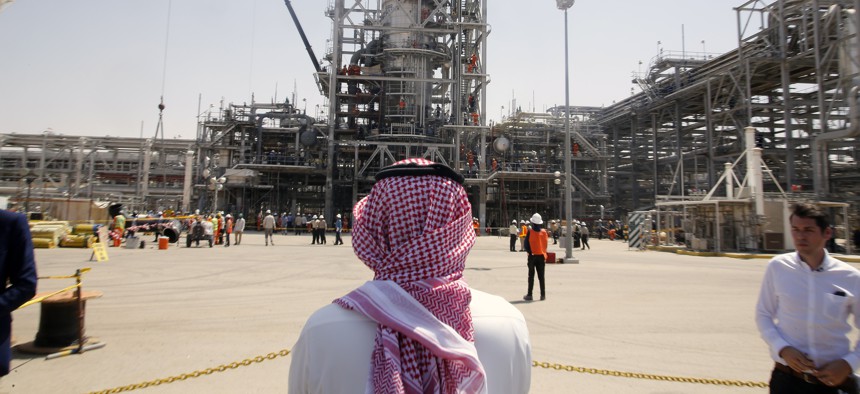
In this photo opportunity during a trip organized by Saudi information ministry, a man stands in front of the Khurais oil field in Khurais, Saudi Arabia, Friday, Sept. 20, 2019, after it was hit during Sept. 14 attack. AP Photo
Is US Deterrence Against Iran Doomed to Fail?
A key ingredient may be missing. And we won’t know until Tehran launches another attack.
Pentagon officials are warning that Iran continues to pose a threat to U.S. forces in the region, despite the additional 14,000 troops deployed there in the last six months.
“We also continue to see indications, and for obvious reasons I won’t go into the details, that potential Iranian aggression could occur,” John Rood, the Pentagon’s number-three official, told reporters on Wednesday morning.
Rood spoke in the wake of a recent report from the Defense Intelligence Agency that warned that Tehran is producing “increasingly capable ballistic and cruise missiles” with better accuracy, lethality and range.
Those warnings come just days after Gen. Kenneth McKenzie, the leader of U.S. Central Command, told reporters traveling with him that even if the additional troops, jets, and defensive missiles were enough to deter Iran from attacking American targets, he did not expect them to stop Iran from attacking allied Gulf nations.
“My judgment is that it is very possible they will attack again,” McKenzie said.
All this has revived a question raised by a series of Iranian attacks over the summer: Is U.S. deterrence against Iranian aggression in the region “working”?
“I’m not disagreeing with Gen. McKenzie, but I think there’s more to the response than saying they are deterred or they are not deterred,” Rood said Wednesday.
“Deterrence is always a difficult thing to measure,” he said. “Whether [the current deployment level] is ultimately sufficient or not — deterrence is dynamic. We have not made the decision that this is some plateau or fixed point at which U.S. forces will stay.”
What happens when deterrence fails?
U.S. deterrence against Iran in the Gulf has failed before. In the late 1980s, in the midst of the Iran-Iraq War, the U.S. began reflagging Kuwaiti tankers transiting through the Gulf in an effort to deter Iranian attacks — the expectation being that Tehran would not strike a U.S.-flagged vessel.
But on the very first escort mission, in July 1987, the reflagged Kuwaiti oil tanker Bridgeton struck an Iranian underwater mine placed at a depth that could have sunk an escorting warship. The tanker was damaged but there were no injuries. The Bridgeton went on under its own power to Kuwait, while the U.S. Navy escorts followed behind it to avoid hitting another mine.
Rear Adm. Harold Bernsen, the commander of the U.S. Middle East Force in the Persian Gulf from 1986 to 1988, later said that he believed that Tehran was watching Washington and had come to the conclusion that the reflagging operation lacked domestic political support — a key ingredient to any deterrent deployment.
“I think they came to a decision, and I think they bet. The bet that they made was that there was better than a 50-50 chance that if they successfully mined a United States ship, not necessarily a tanker, but a warship, that we might just turn around and leave,” Bernsen said, according to Lee Allen Zatarain’s account, Tanker War. “Those mines, the mine that hit the Bridgeton, were set at a depth such that the USS Kidd or any one of the other escorts could just as likely have been hit and blown sky-high.”
Some close watchers of the Trump administration’s Iran policy suggest that a similar dynamic is playing out in 2019: Iran is betting that because there is little national appetite for a war in the United States, as long as it avoids killing an American, it can continue to target U.S. interests in the area and seek to divide smaller Gulf allies by proving Washington doesn’t care about its regional partners.
The evidence of America’s anemic appetite for a military conflict with Iran is plastered across one of the most public spectacles of American politics, the 2020 presidential election. Democratic primary candidates are vowing to end “forever wars” and President Trump has campaigned on bringing U.S. soldiers “home.” Meanwhile, polling over the summer has shown support for military intervention in Iran to be low. There are few signs that support is rising.
“At the heart of this entire matter is a question of interests and Iran knows that the U.S. is currently in the process of rank-ordering its interests,” said Behnam Taleblu, an Iran policy specialist at the hawkish Foundation for the Defense of Democracies. Preventing an attack on a U.S. interests in the region — like the September drone and cruise missile attack on Saudi Arabia’s oil production facilities, for example — is lower on America’s list than protecting the homeland and its own forces in the region.
Trump may have exacerbated that image when the White House ordered, then canceled, air strikes on Iran in response to the downing of a U.S. drone over the summer. The incident sent the message that the only red-line that Iran could not cross is the death of an American, Taleblu and other analysts say.
“In the Gulf, it’s how much escalation are you willing to absorb before kinetic action is taken?” Taleblu said. “Do you really want to signal that the only red line is the death of an American servicemember?”
America’s key Gulf allies, Saudi Arabia and the United Arab Emirates, seem to have gotten that message, said Chris Bolan, a professor of Middle East Security Studies at the U.S. Army War College and a former foreign policy advisor to former Vice Presidents Bush and Gore. The two Gulf kingdoms, he said, “appear to be backtracking on their willingness to confront Iran directly,” disengaging from the ongoing conflict in Yemen.
“How much of that is a result of failure of a U.S. conventional response to what Iran has been doing — they’re certainly coincidental, whether there’s a cause-and-effect there is a little bit tougher to say,” he said.
But there’s little question that Iran viewed Trump’s decision not to retaliate for the downing of the U.S. drone as a green light, Bolan said.
“He’s responded in sanctions and cyber, but he’s not responded in terms of a conventional military response and I think the hardliners will read that as, ‘we have more freedom of maneuver to push further if we need to.’”
Asymmetric challenges
“The other fundamental challenge for the U.S. in the Middle East is deterring Iran, which is an asymmetric power, through conventional forces alone,” Taleblu said. Since the Trump administration first began warning of a heightened threat from Iran, it has sent Patriot batteries, fighter jets and troops it has dubbed “defensive” to Saudi Arabia and other regional bases. It also launched an offensive cyber attack on Iran in response to the attack on the Saudi oil facilities.
Iran’s “way of war,” according to the DIA report, “emphasizes the need to avoid or deter conventional conflict while advancing its security objectives in the region, particularly through propaganda, psychological warfare, and proxy operations.”
U.S. officials told Reuters that the cyberattack on Iran targeted Tehran’s ability to spread propaganda. That offensive suggests that U.S. deterrence against Iran may be broader than is publicly known, said Bolan.
“What we should be doing is looking at deterrence across the spectrum of conflict. You do that in different discrete ways, but you have to have a much broader approach to deterrence,” he said, agreeing with McKenzie’s assessment that conventional deterrence is probably limited to preventing a direct attack on U.S. forces.
What’s lacking from the current deterrence model for Iran, he said, is not an understanding of how to use asymmetric tools, but an off-ramp for Iran — an incentive for Tehran not to escalate the tensions.
Still, like Rood, he cautioned that it’s next-to-impossible to determine in real time whether deterrence is “working.”
“You don’t know it’s working until it doesn’t work,” he said. “If there’s an attack on a U.S. military force, then you know deterrence has failed.”




